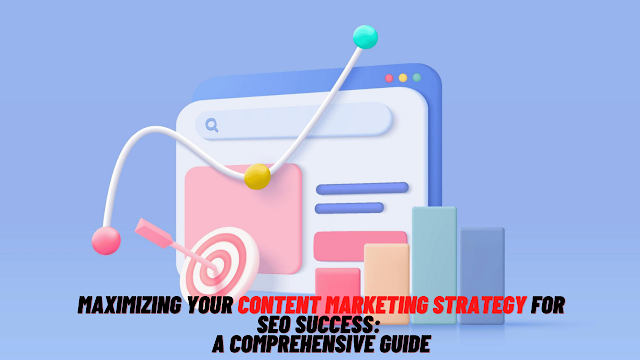Maximizing Your Content Marketing Strategy for SEO Success: A Comprehensive Guide
Maximizing Your Content Marketing Strategy for SEO Success: A Comprehensive Guide
Introduction:
As a business owner, you want your website to be visible to your target audience, and ranking high on search engines is one of the ways to achieve that. But, with millions of websites vying for attention, how do you make your site stand out? The answer lies in your content marketing strategy. When implemented correctly, content marketing can help you build a strong online presence, drive organic traffic, and boost your SEO efforts. In this article, we’ll explore the key elements of a successful content marketing strategy for SEO success.
 |
| Maximizing Your Content Marketing Strategy for SEO Success: A Comprehensive Guide |
Understanding the Basics of Content Marketing and SEO
In simple terms, content marketing is the creation and distribution of valuable, relevant, and engaging content to attract and retain a defined audience with the aim of driving profitable customer action. SEO, on the other hand, is the process of optimizing your website and its content to rank higher in search engine results pages (SERPs). When you combine the two, you get a powerful approach that can help you achieve your business goals.
Key Components of a Successful Content Marketing Strategy
To maximize the benefits of your content marketing strategy, there are several key components to consider:
Define your target audience: Understanding your target audience is crucial to creating content that appeals to them and addresses their pain points. This information can help you determine the topics to write about, the tone to use, and the channels to distribute your content.
Conduct keyword research: Keyword research is the process of identifying the words and phrases people use when searching for information online. By understanding the keywords your target audience is using, you can create content that addresses their needs and increase the chances of your content being discovered.
Create quality content: Creating quality content is the cornerstone of a successful content marketing strategy. Your content should be well-researched, well-written, and engaging. It should provide value to your audience and encourage them to share it with others.
Promote your content: Creating quality content is only half the battle. To reach your target audience, you need to promote your content through a variety of channels, including social media, email marketing, and paid advertising.
Maximizing Your Content Marketing Strategy for SEO Success
Now that you understand the basics of content marketing, let's explore how you can maximize your content marketing strategy for SEO success.
Use Targeted Keywords
One of the most important ways to maximize your content marketing strategy for SEO success is by using targeted keywords in your content. By incorporating relevant keywords into your content, you make it easier for search engines to understand what your content is about and match it with user search queries.
Publish Quality, Unique Content Regularly
Search engines favor websites that regularly publish quality, unique content. By consistently publishing valuable, relevant, and engaging content, you can establish your website as a trusted resource and attract more organic traffic. Aim to publish new content at least once a week, and consider using blog posts, infographics, videos, and other formats to keep your audience engaged.
Optimize Your Content for Readability and User Experience
To maximize the benefits of your content marketing strategy, it's important to optimize your content for readability and user experience. This includes using clear and concise language, breaking up text with headings, subheadings, and images, and making sure that your website is easy to navigate and user-friendly. Additionally, ensure that your content is optimized for different devices, such as desktop, tablet, and mobile. A good user experience can not only keep your audience engaged but also improve your search engine rankings.
Use Social Media and Other Channels to Promote Your Content
Social media and other channels, such as email marketing, can be powerful tools for promoting your content and reaching your target audience. Share your content on social media, reach out to influencers and other relevant websites, and use email marketing to reach your subscribers and drive traffic back to your website.
Measure and Analyze Your Results
Finally, to continuously improve your content marketing strategy for SEO success, it's important to measure and analyze your results. Use tools such as Google Analytics to track your traffic, engagement, and conversions, and make data-driven decisions to improve your approach.
FAQs
Q: What is the difference between content marketing and SEO?
A: Content marketing is the creation and distribution of valuable, relevant, and engaging content to attract and retain a defined audience with the aim of driving profitable customer action. SEO is the process of optimizing your website and its content to rank higher in search engine results pages (SERPs).
Q: How often should I publish new content?
A: To establish your website as a trusted resource and attract more organic traffic, aim to publish new content at least once a week.
Q: What are the key components of a successful content marketing strategy?
A: The key components of a successful content marketing strategy include defining your target audience, conducting keyword research, creating quality content, and promoting your content.
Conclusion:
Maximizing your content marketing strategy for SEO success requires a strategic approach and a focus on quality content and promotion. By using targeted keywords, regularly publishing new content, optimizing your content for readability and user experience, promoting your content through social media and other channels, and measuring and analyzing your results, you can achieve your business goals and establish a strong online presence. Remember, the key to success is to continually refine your approach and make data-driven decisions.






Post a Comment